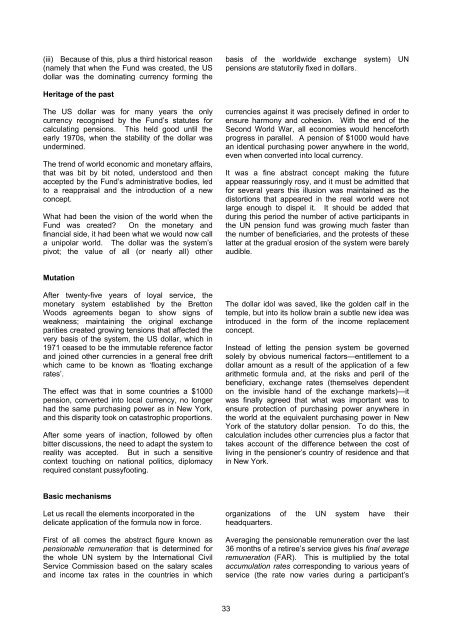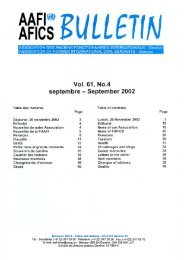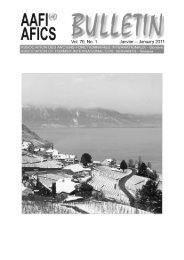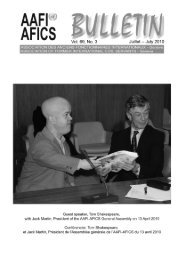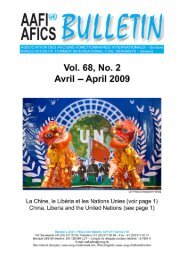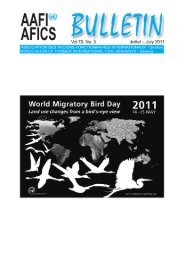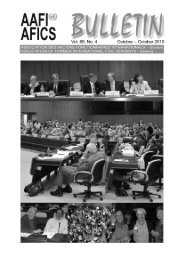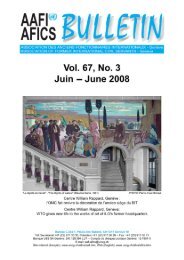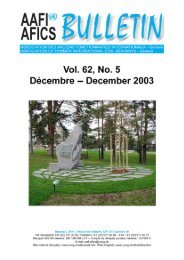(iii) Because of this, plus a third historical reason(namely that when the Fund was created, the USdollar was the dominating currency forming thebasis of the worldwide exchange system) UNpensions are statutorily fixed in dollars.Heritage of the pastThe US dollar was for many years the onlycurrency recognised by the Fund’s statutes forcalculating pensions. This held good until theearly 1970s, when the stability of the dollar wasundermined.The trend of world economic and monetary affairs,that was bit by bit noted, understood and thenaccepted by the Fund’s administrative bodies, ledto a reappraisal and the introduction of a newconcept.What had been the vision of the world when theFund was created? On the monetary andfinancial side, it had been what we would now calla unipolar world. The dollar was the system’spivot; the value of all (or nearly all) othercurrencies against it was precisely defined in order toensure harmony and cohesion. With the end of theSecond World War, all economies would henceforthprogress in parallel. A pension of $1000 would havean identical purchasing power anywhere in the world,even when converted into local currency.It was a fine abstract concept making the futureappear reassuringly rosy, and it must be admitted thatfor several years this illusion was maintained as thedistortions that appeared in the real world were notlarge enough to dispel it. It should be added thatduring this period the number of active participants inthe UN pension fund was growing much faster thanthe number of beneficiaries, and the protests of theselatter at the gradual erosion of the system were barelyaudible.MutationAfter twenty-five years of loyal service, themonetary system established by the BrettonWoods agreements began to show signs ofweakness; maintaining the original exchangeparities created growing tensions that affected thevery basis of the system, the US dollar, which in1971 ceased to be the immutable reference factorand joined other currencies in a general free driftwhich came to be known as ‘floating exchangerates’.The effect was that in some countries a $1000pension, converted into local currency, no longerhad the same purchasing power as in New York,and this disparity took on catastrophic proportions.After some years of inaction, followed by oftenbitter discussions, the need to adapt the system toreality was accepted. But in such a sensitivecontext touching on national politics, diplomacyrequired constant pussyfooting.The dollar idol was saved, like the golden calf in thetemple, but into its hollow brain a subtle new idea wasintroduced in the form of the income replacementconcept.Instead of letting the pension system be governedsolely by obvious numerical factors—entitlement to adollar amount as a result of the application of a fewarithmetic formula and, at the risks and peril of thebeneficiary, exchange rates (themselves dependenton the invisible hand of the exchange markets)—itwas finally agreed that what was important was toensure protection of purchasing power anywhere inthe world at the equivalent purchasing power in NewYork of the statutory dollar pension. To do this, thecalculation includes other currencies plus a factor thattakes account of the difference between the cost ofliving in the pensioner’s country of residence and thatin New York.Basic mechanismsLet us recall the elements incorporated in thedelicate application of the formula now in force.First of all comes the abstract figure known aspensionable remuneration that is determined forthe whole UN system by the International CivilService Commission based on the salary scalesand income tax rates in the countries in whichorganizations of the UN system have theirheadquarters.Averaging the pensionable remuneration over the last36 months of a retiree’s service gives his final averageremuneration (FAR). This is multiplied by the totalaccumulation rates corresponding to various years ofservice (the rate now varies during a participant’s33
career; it represents a percentage of the FARaccumulating for each year of service to give thepension entitlement). The result of this calculationis the basic dollar pension.This basic pension represents the pensioner’sincome replacement. As the name implies, itreplaces the income a retiring civil servantreceived whilst still active, and is intended topermit a comparable standard of living inretirement. Just as there is only one pensionableremuneration scale for the whole world, and thatthe salary scale (at least for the professionalcategory) is adapted for each duty station bymeans of a post adjustment in order to try toensure a comparable, if not identical, standard ofliving to all active civil servants wherever they areserving, the FAR can only reflect standards ofliving at New York, the hub of the system. Thisfact was long ignored, but is now taken intoaccount thanks to the mechanisms describedbelow. (The system applicable to the GeneralServices category is similar: the reference centrehowever is not automatically New York but thecountry where they served and the salaries there inforce)In order to adjust the basic US dollar pension to meetconditions in certain other countries, a supplementcalled the cost-of-living differential (COLD) factor isapplied. It is the three-year mean difference betweenthe cost of living in New York and in the pensioner’scountry of residence as measured by the number ofclasses in the P-staff local post adjustment. (For GSstaff, the measurement is the differences inremunerations between the country where they servedand the country of residence). This COLD factor maybe reduced if the rate of income tax payable in thecountry of residence is less than the staff assessment.Finally, the amount of dollars produced by theseoperations is converted into local currency by applyingthe 36-month mean exchange rate of the localcurrency with the US dollar. This represents thestarting point of the pension on the local-currencytrack. It will subsequently be adjusted in accordancewith movements of the local consumer price indexrather than that of New York which governs the USdollar track.The current state of the systemLet us have a look at the system as it stands now:(i) The statutory pension remains thatestablished in US dollars and adjusted inaccordance with the cost of living in New York;(ii) At the request of the retiree, it can also beestablished in the currency of the country ofresidence and adjusted in accordance withthe cost of living there.This schematic presentation calls for certainremarks and clarifications:1.1 The basic pension is always calculated in USdollars (in any case, if only for practical reasonsthe Fund continues to be financially managed indollars).1.2 The dollar pension remains universal. Itis calculated as if the pensioner were living in theUSA and can be paid as such anywhere in theworld; it is adjusted only according to pricemovements in New York, the hub of the system.1.3 Even so, at the pensioner’s request thedollar pension can be paid to him in any currencyhe chooses, conversion from US dollars beingat the official UN exchange rate.2.1 At the pensioner’s request, his pensioncan also be calculated in the currency of hiscountry of residence. The request may be lodgedat any time, and is applied as if it had been madeat the moment of separation. The local-track isestablished according to the average exchange rateduring the last three years of participatory activeservice, the cost-of-living differential (if any) isreconstituted for the same period, and local consumerprice index movements since the date of entry into thelocal-track system then applied.2.2 This local track pension is from then onadjusted in accordance with movements in theconsumer price index of the country of residence.2.3 The pensioner must provide proof ofresidence in that country.2.3 Once in effect, the local currency optioncannot be revoked. Except under exceptionalcircumstances, it will never be possible to revert to thesingle track US dollar pension. The only exception tothis rule might be when, for compelling personalreasons, the pensioner changes country of residence.2.4 However, choice of the local-currency trackdoes not mean that all contact with the US dollarpension is lost. It is, after all, the pensioner’s statutoryentitlement. Thus for all beneficiaries who select thelocal-track pension option, the Fund keeps a parallelaccount of what it would be on the dollar track, whichis why it is commonly known as the dual-track system.2.5 The local track evolves only according to thelocal cost of living; it is impervious to exchange-ratevariations and gives full protection against anyweakening of the system’s standard currency, the USdollar. That is in fact its historical raison d’être.2.6 The dollar track (which as initially conceived aspart of the dual track system was rudimentary: just the34


